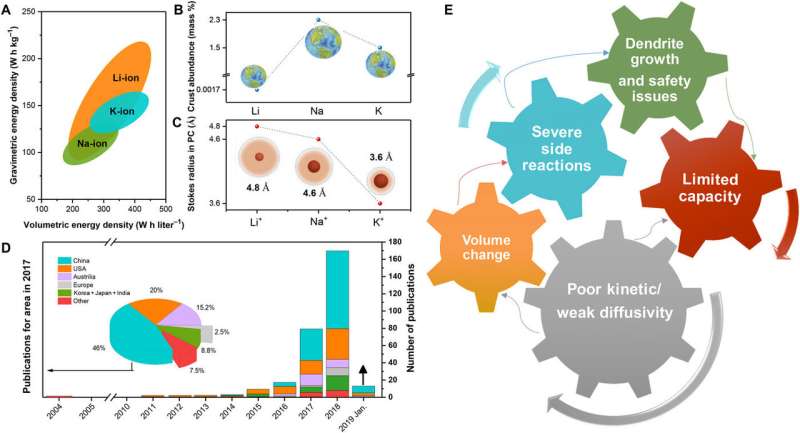May 13, 2019 report
Researchers outline the current state of potassium-ion battery technology

A trio of researchers with the University of Wollongong, in Australia, has published an outline of the current state of potassium-ion battery technology. In their Review piece published in the journal Science Advances, Wenchao Zhang, Yajie Liu, and Zaiping Guo highlight the current roadblocks that are preventing widespread use of the battery technology and possible workarounds for them.
Lithium-ion batteries have proven to be very useful, particularly in recent times as they are used to power a wide range of devices—from smartphones to electric cars. But lithium is rather rare, which means costs for it is going to go up as supplies tighten. For that reason, scientists have been searching for an alternative. One alternative that has been getting a lot of attention of late is potassium-ion—it is plentiful and cheap. But it also has five main roadblocks, the researchers note.
The first roadblock is low diffusion, which means the potassium ions move slowly through a solid electrode. The researchers suggest that advances in nanomaterials and nanostructures may lead to ways to solve this problem.
The second roadblock has to do with the changes in volume that potassium undergoes as it first accepts a charge and then as it releases it. Repeated cycles lead to breakdown of the material, which results in the development of dead areas and ultimately, battery failure. Possible workarounds include using nanoparticle clusters.
The third problem involves the side reactions that take place that can lead to degradation. The researchers expect that additives will soon be found to prevent them.
The fourth problem is the growth of dendrites that can lead to short circuits. Again, the researchers suggest that the introduction of the right solvents should be able to prevent them from occurring.
And finally, the fifth problem is poor heat dissipation, which can result in very hot batteries or even thermal runaway. The researchers suggest that study of electrode materials, cell configuration and electrolytes should at some point lead to a way to solve the problem.
The researchers conclude by suggesting that the problems inherent with using potassium in batteries do not appear to be insurmountable, but acknowledge that it could take as long as 20 years to figure them all out.
More information: Wenchao Zhang et al. Approaching high-performance potassium-ion batteries via advanced design strategies and engineering, Science Advances (2019). DOI: 10.1126/sciadv.aav7412
Journal information: Science Advances
© 2019 Science X Network





















